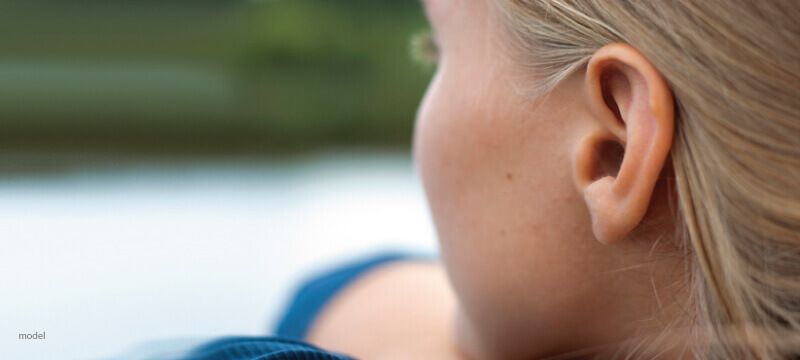What You Need to Know About Earlobe Rejuvenation

The earlobes, just like our skin, is susceptible to showing unwanted signs of aging. Earlobes can sag or become overly thin through the process of natural aging or the culmination of years of wearing large and heavy earrings. Even worse, lobes can become torn or stretched through gauging or accidents like becoming caught on clogging or being pulled by a child.
Fortunately, there are effective surgical and non-surgical earlobe rejuvenation techniques can be performed to restore aged earlobes or correct tears and other forms of damage.
Earlobes and Aging
As earlobes age, they lose elastin and collagen just as out skin does. This causes them to become thinner, wrinkled or creased. If you have pierced ears, aging is often most apparent around the piercing and can lead to difficulty wearing earrings. Earrings droop forward and refuse to stay in place. Wrinkles appear around pierced holes, or they may further elongate.
With or without earrings, aged earlobes can affect symmetry in the face and may increase the appearance of aging. Aging earlobes are typically most noticeable after the age of 40, but there are some avoidable factors that increase this process.
Common Factors That Cause Earlobe Aging
Sun Exposure
Because the ears protrude slightly from the head, they are almost always exposed to the sun. The ears are also an area that’s often forgotten when it comes to applying sunscreen. In fact, the ears are among the most frequent places that basal cell carcinomas, the most common type of skin cancer, are found.
To protect your ears from collagen and elastin damage, avoid excessive sun exposure, wear wide brimmed hats when outdoors, and always wear a full-spectrum sunscreen that protects against both UVA and UVB rays.
Heavy or Large Earrings
Years of wearing heavy or large earrings pulls on the earlobes over time and speeds gravity’s aging effect. As we age, we also lose elastin, which gives skin its ability to bounce back after stretching. Heavy earrings can elongate pierced holes and the earlobe itself.
To avoid sagging earlobes, choose smaller, lighter earrings for daily wear, and limit larger earrings to special events. Give your ears a break by removing large or heavy earrings during the day when possible.
Sleeping with Earrings On
It’s tempting to sleep with earrings on, especially if they are small. Yet the pressure caused by side sleeping with earrings on can damage earlobes and cause stretching or widening of pierced holes. To avoid permanent damage, always remove your earrings before going to bed, even if they’re only studs.
Repairing Sagging Earlobes with Filler
Sagging earlobes can easily be remedied with the injection of a minimal amount of dermal filler. Dermal fillers plump earlobes for a more youthful appearance, and can help prop earrings into their correct, upright positions.
The best dermal fillers for sagging earlobes are those that contain hyaluronic acids. Fillers such as Restylane and Belotero create more volume and boost the skin’s natural collagen building process. These types of fillers tend to last longer in the ears than in the face since the ears are not muscled and moving.
Earlobe rejuvenation with dermal fillers is a quick process that requires just a 15-minute office visit. The treatment is much simpler than facial dermal fillers since the ears lack the complex network of blood vessels that are found in the face.
Results are immediate and there’s no downtime. Treatments last anywhere from 6 months to two years, although most patients choose to return for a touch up after one year.
Earlobe Repair Surgery for Torn or Stretched Lobes
Earrings get caught on clothing, children reach up and grab their mother’s hoops, and earlobes can become significantly damaged from heavy earrings that elongate lobes and earring holes. Sometimes, those who intentionally stretch their earlobes in their youth change their minds as they get older.
Significant stretching or torn earlobes are corrected via two common types of earlobe repair surgery procedures:
Earlobe Reshaping Surgery is best for elongated piercing holes. In this procedure, the lining of your old piercing is removed and the hole is stitched back together. Approximately one week later, your stitches will be removed. After 8 weeks the lobes fully hear and can even be pierced again.
Earlobe Repair Surgery is required for excessively stretched or nearly torn lobes. In this more involved procedure, a pizza-shaped wedge is removed from the bottom of the earlobe. The lobe is then stitched back together, which results in a shortened earlobe.
Both forms of earlobe repair surgery are relatively quick and simple procedures that can be performed within an hour using local anesthesia.
To learn more about otoplasty (cosmetic ear surgery) please see this case study or view our before and after photo gallery.
What to Expect After Earlobe Surgery?
Most patients fully heal within 6 weeks after earlobe repair surgery and typically don’t require pain medication after the procedure. Earlobe reshaping is scar-free, while earlobe shortening results in a small scar that can be covered up with future earring use.
The results of earlobe repair surgery are nearly permanent if the patient makes sure to follow the suggestions above to avoid future earlobe stretching.

Yeah.. this is very handy, thanks for putting it up…